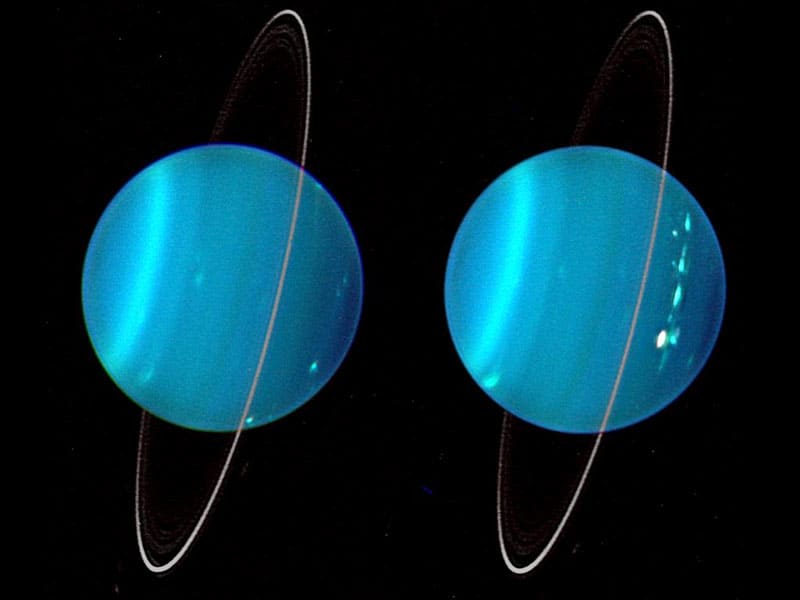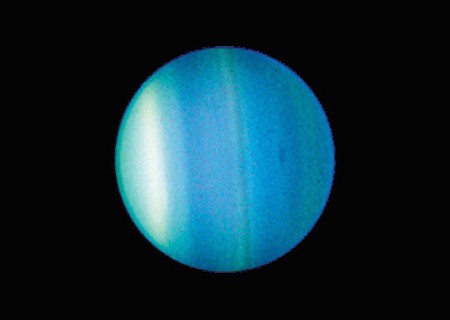The planet Uranus is named after the ancient Greek God of the heavens, the earliest supreme god. He was the father of Cronus / Saturn, which in turn, was the father of Zeus / Jupiter.
Key Facts & Summary
- Uranus is the seventh planet from the Sun, and the third-largest planet in the Solar System It is the biggest of the ice giants.
- Uranus is 2.9 billion kilometers / 1.8 billion miles away from the Sun.
- Uranus has a radius of 25.362 km / 15.759 mi, and a diameter of 51.118 km or 31.763 mi.
- It comparison to Earth’s mass, Uranus has around 14.5 times the mass of Earth. It has the fourth-largest mass in the Solar System.
- Uranus rotates in the opposite direction than most planets, from East to West. It is also the only planet known to rotate on its side.
- Uranus has the coldest planetary atmosphere in the Solar System. Temperatures are on average at around -224 degrees Celsius / -371 degrees Fahrenheit.
- Both Uranus and Neptune share similar compositions. Their chemical compositions differ from the other gas giants Jupiter and Saturn. Because of this, Uranus and Neptune are classified as ice giants rather than gas giants, for easier distinction.
- Uranus has a similar atmosphere to Jupiter and Saturn in its primary composition of hydrogen and helium. However, it contains more “ices” such as water, ammonia, methane, and traces of other hydrocarbons.
- Uranus has 13 known rings surrounding it but they are difficult to observe.
- The reason why Uranus is blue is due to the presence of methane.
- Uranus has 27 moons orbiting it. There may be more, all of them are very small.
- The biggest moon of Uranus is Titania. It is the eighth largest moon in the Solar System.
- Uranus has been visited only once by a spacecraft, namely, Voyager 2.
- Another moon of Uranus, Miranda, is one of the strangest objects in the Solar System. It has a very deformed landscape with strange and hard to explain patters.
Uranus is the seventh planet from the Sun and the third largest of all the planets in our Solar System. Both Uranus and Neptune are considered ice giants due to their different compositions from the other gas giants Jupiter and Saturn.

Both Uranus and Neptune are blue because they have methane. Uranus is larger in size than Neptune but it is smaller in weight. It has thirteen ring systems and 23 confirmed moons.
Structure and Composition
Every gas giant lacks the presence of a surface. Uranus is made of water, methane, and ammonia fluids above a small rocky center. The thick atmosphere is made of hydrogen and helium like Jupiter and Saturn.

The rings of Uranus can be summarized into two sections. The inner rings and the outer rings. The inner rings are narrow and very faint. The outer rings are brightly colored and easier to see.
The clouds on Uranus are difficult to see ,but they are present. Some of these clouds were observed ,and they revealed huge storms as big as the United States.
Some of the wind speeds recorded on Uranus were among the most powerful ever witnessed in the Solar System.
Time on Uranus
Uranus has a shorter day than Earth. One day only lasts 17 hours. One year on Uranus, or the time it takes for it to circle the Sun once, it the equivalent of 84 Earth years. Having to wait for a birthday cake for 84 years is no fun!
Fun Facts:
- The biggest moons of Uranus, all of them, have surface areas smaller than the continent of Australia.
- The rings of Uranus are thought to have formed around 600 million years ago from the collision of moons or other big celestial objects.
- The rings of Uranus are unique since they are dark and extremely narrow.
- The intensity of light on Uranus is about 1/400 of that on Earth.
- In good conditions, Uranus can be seen without binoculars.
- Umbriel, one of the biggest moons of Uranus, has a very dark surface. It consists mainly of ice and only a fraction of rock.
- William Herschel, the discoverer of Uranus, first believed that the planet was a comet. However, years later it was confirmed to be a planet.
- The original name proposed for Uranus was Georgian Sidus – which means Georgian Planet, in honor of King George II, however, the scientific community didn’t agree. In a way, we are thankful for that even now.
- Uranus has a very unusual axial tilt. Many believe that this was caused by a collision with an Earth-sized planet.
- Uranus is the lightest out of all the four gas giants.
- The Uranian moons are named for characters created by Alexander Pope and William Shakespeare.
Size and Comparison
Uranus has a radius of 25.362 km / 15.759 mi and a diameter of 51.118 km or 31.763 mi. It is the third-largest planet in the Solar System and the biggest of the ice giants.

Uranus is slightly larger than Neptune, however, it is smaller in mass. In comparison to Earth, Uranus has four times its diameter. When it comes to volume, 63 Earths could fit inside Uranus.
Both Neptune and Uranus have 10 times the diameter of Mercury, the smallest planet in the Solar System. Jupiter, the largest planet in the Solar System, has 2.8 times the diameter of Uranus.
Trivia
A name for a planet, a name for an element
The common tradition after naming a new planet is to name a newly discovered element after the planet, a sort of variant. In the case of Uranus, the chemical element Uranium, discovered in 1789, was named after the newly discovered planet.
The first planet discovered
Uranus is the first planet discovered in modern history. The planet was too dim to be seen by ancient civilizations and as such it remained hidden in the darkness of the sky.
Other Characteristics
Uranus is probably the coldest planet of the Solar System for reasons not yet understood. Something prevents the heat from Uranus’s core from reaching the surface.

Uranus is the only planet in the Solar System that spins on its side. It is believed that this was caused by a collision in the distant past. Like Venus, Uranus also spins in the opposite direction than the other planets of the Solar System.
The closest planets to Uranus, its neighbors, are Neptune and Saturn. Uranus has many moons, 27, and they were named after characters from fictional books.

Uranus was discovered in 1781 by William Herschel, a British astronomer. The planet was visited only once, by the spacecraft Voyager 2, in 1986.
Uranus is sometimes visible in the sky. You won’t need binoculars or a telescope to see it, but you can only view it on a very clear night sky. Even with binoculars, it would be easy to spot the planet.
Uranus Notes
- Uranus is a gas giant like Neptune, Saturn, and Jupiter. However, since it has a different composition, both Uranus and Neptune are termed, ice giants.
- Uranus is the coldest planet of the Solar System and the only planet which spins on its side. It also spins in the opposite direction of most planets.
- Uranus has 27 moons, but there may be more out there, hidden in its thirteen ring systems.
- Though Uranus may seem peaceful, it does have violent storms, and since it doesn’t have a surface, life wouldn’t be able to develop there.
- Uranus is 20 times further away from the Sun than Earth.
- In 2033, Uranus will complete its third orbit/year around the Sun since its discovery in 1781.
- Uranus has a bluish appearance due to the presence of methane, a type of gas. This is also why Neptune appears blue.
- It isn’t known what prevents Uranus’s heat from the core to reach its surface.
Sources:
[1.] Wikipedia
[2.] NASA
Image sources:
- https://solarsystem.nasa.gov/system/stellar_items/image_files/69_feature_1600x900_uranus_new.jpg
- https://solarsystem.nasa.gov/system/feature_items/images/88_carousel_uranus.jpg
- https://spaceplace.nasa.gov/review/all-about-uranus/uranus2.en.jpg
- https://cdn.mos.cms.futurecdn.net/rCdTVsPesASiv3JeVyhHsa-1200-80.jpg
- https://www.nasa.gov/sites/default/files/thumbnails/image/potw1714a.jpg
